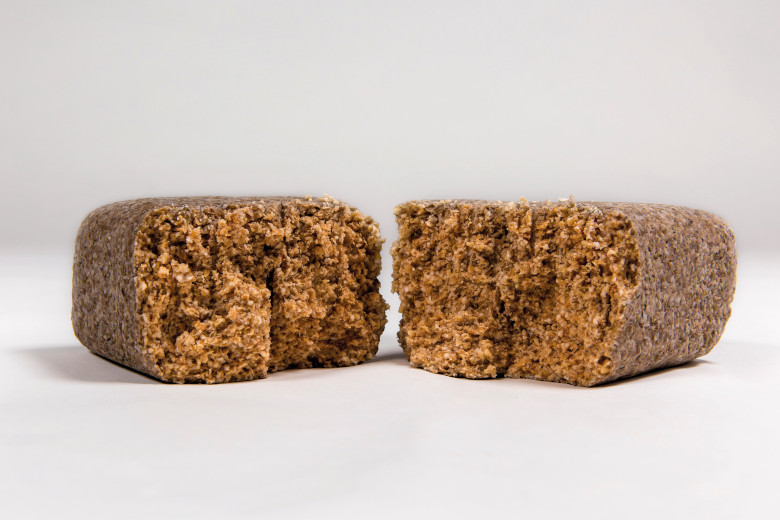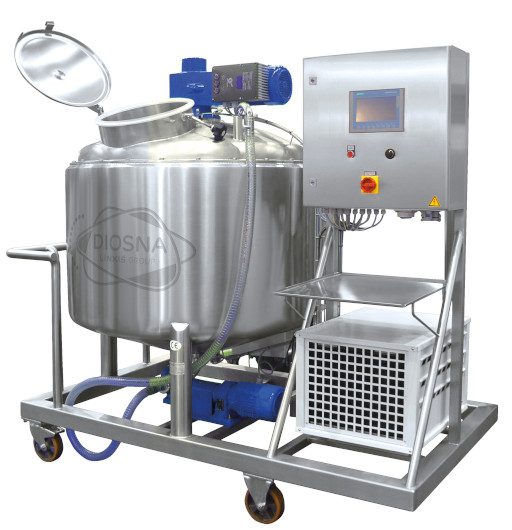
No two sourdoughs are the same; its value lies in its diversity. Perfecting different sourdough specialties relies on process accuracy and stability, with optimum kneading and mixing parameters for each type of product.
Simply sourdough: DIOSNA
To optimize sourdough processing, the best place to start is by learning the starter itself. An important characteristic of starter cultures is stability: they must be stable in terms of microbiological quantity (concentration of microorganisms) and quality (representation of the background species). The starter cultures ensure the repeatability of the fermentation and, therefore, the sourdough’s stability – which is determined by the pH and TTA parameters. Stable fermentation parameters such as temperature, time, dough yield and percentage of starter or mother sourdough also contribute to the consistency of the resulting sourdough.
Working with user-friendly starter cultures also goes a long way to maintaining their stability. DIOSNA’s starter cultures, for instance, can be used as semi-solid starters, which are easy to crumble, or as liquid starters. Both can be used for artisan production as well as for industrial solutions.
A useful classification

Rye sourdoughs can be divided into solids, which are prepared in bowls, and liquids – fermenters are used for their preparation. Stiff rye sourdoughs are more demanding in terms of preparation and space, which is why bakeries tend to prefer using liquid sourdoughs. Liquid sourdough, in turn, can be divided into active and stable sourdough. Active sourdough has a certain leavening power and requires cooling. Stable sourdoughs are characterized by a higher acidity and a long fermentation time without the need for cooling. A special stable fermentation is used for bread fermentation, for which it is possible to ferment up to 50% of the weight of the flour in the sourdough.
From a processing standpoint, rye sourdoughs can be divided into single or multi-stage fermentation. For the most part, there is a preference for using single-step rye sourdoughs. Depending on the bakery and the region, active and stable rye sourdoughs are chosen.
Wheat pre-doughs can be divided into two groups of their own: yeast pre-dough (pre-dough), which uses yeast as a starter (examples include biga, poolish, or opara), and sourdough – for which lactic bacteria are used as a starter.
Wheat pre-dough can either be stiff or pumpable. Solid pre-doughs are fermented in bowls or boxes and are more demanding in terms of preparation, handling and space. By contrast, liquid pre-doughs are prepared in fermenters – meaning that it is possible to cool them and extend their usability. “The equipment for wheat pre-dough can work according to our standard yeast pre-dough and sourdough parameters, or according to the client´s parameters if requested,” DIOSNA explains. The choice between wheat yeast pre-dough and sourdough can vary according to the character of the product and the region’s established preferences.
Starting sourdoughs
Recipes are commonly developed based on the properties that are expected of the final product, in terms of smell, taste, crumb, elasticity, volume, and other characteristics. Various alternatives are available to choose from, according to how well they match these expectations: wheat sourdough, rye sourdough, or wheat yeast-pre-dough (or other scalding dough and aroma pre-dough (AromaStück®). The product is then trialed, made with one or more pre-/sourdoughs with different amounts of pre-dough, and evaluated.
When the optimum dough recipe is identified, the corresponding pre-dough system is then calculated and designed, according to the recipe and the capacity needed by the production line (or lines).
Kneading options
Conveniently, sourdoughs are not partial to a specific kneading technology – they can be processed with optimum results on universal kneaders, i.e., wendel mixers, as well as spiral mixers from DIOSNA’s portfolio. The choice between available options is determined by the recipe: mid-soft and soft types of dough for products such as bread, buns and ciabatta, or soft yeast doughs, both wendel and spiral kneaders are suitable choices.

To optimize kneading parameters, the correct timings are given by attributes such as:
- The flour: wheat or rye content: wheat dough needs much more energy to develop the gluten structure
- DY level: softer doughs need longer kneading time, while stiffer doughs need less time for the process
- Tool(s): spiral, wendel, L-shape mixers and others; using the wendel mixer, 1/2 to 2/3 of the kneading time can be achieved compared to the spiral mixer
- Mixing style: two gears or more steps with Frequency inverter (FI)
- The type of dough: doughs with a higher content of sugar, eggs, fats and oxidants in the recipe need longer mixing times
- pH: the lower the pH of dough and reductants, the shorter the kneading times
- Dough temperature
- Pre-dough content: using more pre-dough can result in a shorter mixing time requirement (0-10% of mixing time)
A matter of time
The mixing time is defined by the dosing speed of flour and water, the intensity setting of the blending process and by the kind of flour. Blending and mixing pre-/sourdough are done quickly, usually within 15 minutes after filling the fermenter (for wheat with 200 Dough Yield (DY) and rye sourdough with ≥ 220 DY).
The mixing process itself is more complex for wheat flour, which must avoid creating lumps through adequate stirring. Dosing can be carried out automatically, in the fermenter, where the intended amounts of water and flour are simultaneously brought together and mixed with high intensity, or in the mixing pump, from where the homogenous suspension is delivered to the fermenter.
Using pre-dough or sourdough can reduce the kneading time required by up to 10%, depending on the type of dough as well as the kind and amount of pre-/sourdough. For reference (detailed in Tables 1-2), a full bowl of standard wheat dough will require 9 minutes for kneading with a DIOSNA spiral kneader: 3 minutes running at the first speed, followed by 6 minutes using the second speed. With a wendel kneader, kneading a full bowl of the same mix will require 5 minutes (1.5 for the first speed, and respectively 3.5 minutes at the second speed).
For fermentation, the ideal time is defined according to the kind of sourdough used. For example, DIOSNA’s standard fermentation times for DIOstart/yeast are the following: 42 hours for bread fermentation, 18 hours for wheat sourdough, and 4 hours for yeast wheat pre-dough.

Time vs. temperature balance: trust the process
The optimal fermentation process is the result of the correct balance between time and temperature. To control the product temperature, fermenters have cooling or cooling/heating units, connected to the facility’s central cooling/heating systems. AromaStück®, for example, has a standard heating time of 3 hours at 65°C. The process is enzymatic, and no microbiological fermentation occurs. Scalding dough has a heating time of 0.5-2 h, depending on the raw material (e.g., 0.5 h for flour, flakes; 2 h for whole grain). In this case, the main process is gelatinization.
Temperature changes, from the process and from the environment, should be accounted for. In the fermenter, the pre-dough is cooled by coming into contact with the fermenter’s surface. “The cooling time is defined by the temperature of the cooling medium, the flow of the cooling medium, the intensity of stirring and the temperature gradient between the pre-dough and cooling medium,” DIOSNA explains. Cooling may not always be required: rye bread with a long fermentation time can work well at room temperature (22-26°C), without the need for cooling the fermenters, for instance.
Examples of fermentation temperatures:
- Rye, wheat and spelt sourdough:
- At warmer guiding (> 28°C), a strong aromatic taste of the baked goods is achieved
- At colder guiding (26-28°C) high gas activity, the yeast can be reduced in this case
- Bread fermentation:
- First stage temperature (isofermenter): 32°C
- Starting temperature: 28°C; after 16-24 h: max 32°C
- Gluten-free sourdough
- With warmer guiding (> 32°C), the result is an aromatic strong taste in the baked goods
- With colder guiding (28-32°C), results in a yoghurt-like taste
- AromaStück®: the fermentation temperature is 65°C
- Scalding dough: the fermentation temperature is 75-85°C
The processing time of sourdough is also dependent on the storage temperature. The processing times for wheat sourdough and rye sourdough are:
- 8 hours (without cooling)
- 24 hours (with cooling, i.e. cooling to around 15°C after the fermentation time)
- 48 hours (with cooling, i.e. cooling to around 10°C after fermentation)
- 72 hours (with cooling, i.e. cooling to around 6°C after fermentation)
The processing time of wheat yeast pre-dough is shorter than that of wheat sourdough. In industrial bakery operations, the processing time of rye bread is four days – without cooling. When manufactured in a craft bakery environment, a week is required.
Product properties and consistency rely on process control, which is especially important when long-term fermentation products are made, such as products made using sourdoughs. The sourdough system shares information about the current processing step (filling fermenter, fermentation, cooling, ready to use), the amount of sourdough (kg), the age of the sourdough (h), its temperature (°C), and style of blending. The most important parameters are the time and temperature of each process step.
To monitor the sourdough throughout the mixing and kneading process, the pH meter is an option, as its values provide information that can be used to evaluate the sourness of the dough. The correct time and temperature as defined by the sourdough’s recipe are controlled automatically by the cooling (or cooling-heating) medium.
The system keeps these two parameters within predefined values for each step. The result: sourdough with stable properties.
The full article was published in Baking+Biscuit International, issue 2 – 2024.
Photos: DIOSNA


